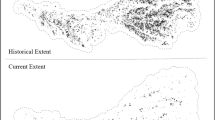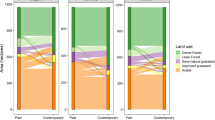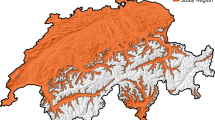Abstract
Context
Agricultural expansion is the greatest source of wetland loss in the Prairie Pothole Region (PPR) of North and South Dakota, a critical waterfowl production area in North America. It is unknown how wetland losses from grassland conversion may alter structural connectivity in the prairie pothole network, however.
Objectives
We examined how agricultural expansion over the period 2001–2011 altered the number, size, shape, and structural connectivity of PPR wetlands. We hypothesized that the loss of wetlands or wetland area would decrease structural connectivity on the landscape.
Methods
We analyzed a published raster database that quantified 2001–2011 agricultural conversion of wetlands in the Dakotas. A suite of structural connectivity metrics was computed using the igraph R package.
Results
Wetland area decreased by 25% within the study area, density decreased by 16%, and average size decreased from 2.41 to 2.16 ha with no increase in perimeter:area ratios, thus indicating changes more from the splitting of larger wetlands (accounting for 23% of area lost) and “nibbling” at patch area (38%) than from complete wetland elimination (39%). Despite loss of wetlands and wetland area to cropland, however, the network did not display constrained structural connectivity.
Conclusions
Structural connectivity has not been significantly affected by wetland losses because of the large number of remaining wetlands, but wetlands will continue to be lost with ongoing grassland conversion and climate shifts. It is unknown where the tipping point of wetland losses lies in the PPR that will incur ecological costs.






Similar content being viewed by others
References
Albanese G, Haukos DA (2017) A network model framework for prioritizing wetland conservation in the great plains. Landscape Ecol 32:115–130
Bélisle M (2005) Measuring landscape connectivity: the challenge of behavioral landscape ecology. Ecology 86:1988–1995
Bishop-Taylor R, Tulbure MG, Broich M (2015) Surface water network structure, landscape resistance to movement and flooding vital for maintaining ecological connectivity across Australia’s largest river basin. Landscape Ecol 30:2045–2065
Boryan C, Yang Z, Mueller R, Craig M (2011) Monitoring US agriculture: the US Department of Agriculture, National Agricultural Statistics Service, Cropland Data Layer Program. Geocarto Int 26:341–358
Claassen R, Carriazo F, Cooper JC, Hellerstein D, Ueda K (2011) Grassland to cropland conversion in the Northern Plains: the role of crop insurance, commodity, and disaster programs. USDA Economic Research Service, Washington, DC
Collins SD, Heintzman LJ, Starr SM, Wright CK, Henebry GM, McIntyre NE (2014) Hydrological dynamics of temporary wetlands in the southern Great Plains as a function of surrounding land use. J Arid Environ 109:6–14
Csardi G, Nepusz T (2006) The igraph software package for complex network research. InterJ Complex Syst 1695:1–9
Dahl TE (2014) Status and trends of prairie wetlands in the United States 1997 to 2009. Department of the Interior, Fish & Wildlife Service, Ecological Services, Washington, DC
Downing JA, Prairie YT, Cole JJ, Duarte CM, Tranvik LJ, Striegl RG, McDowell WH, Kortelainen P, Caraco NF, Melack JM, Middelburg JJ (2006) The global abundance and size distribution of lakes, ponds, and impoundments. Limnol Oceanogr 51:2388–2397
Drake JC, Griffis-Kyle KL, McIntyre NE (2017) Graph theory as an invasive species management tool: case study in the Sonoran Desert. Landscape Ecol 32:1739–1752
ESRI (2017) ArcGIS v10.5. Environmental Systems Research Institute, Redlands
Faber S, Rundquist S, Male T (2012) Plowed under: how crop subsidies contribute to massive habitat losses. Environmental Working Group, Washington, DC
Fahrig L (2007) Non-optimal animal movement in human-altered landscapes. Funct Ecol 21:1003–1015
Fairbairn SE, Dinsmore JJ (2001) Local and landscape-level influences on wetland bird communities of the Prairie Pothole Region of Iowa, USA. Wetlands 21:41–47
Fall A, Fortin M-J, Manseau M, O’Brien D (2007) Spatial graphs: principles and applications for habitat connectivity. Ecosystems 10:448–461
Fausti SW (2015) The causes and unintended consequences of a paradigm shift in corn production practices. Environ Sci Policy 52:41–50
Galpern P, Manseau M, Fall A (2011) Patch-based graphs of landscape connectivity: a guide to construction, analysis and application for conservation. Biol Cons 144:44–55
Gibbs JP (1993) Importance of small wetlands for the persistence of local populations of wetland-associated animals. Wetlands 13:25–31
Girvan M, Newman MEJ (2002) Community structure in social and biological networks. Proc Natl Acad Sci 99:7821–7826
Homer C, Dewitz J, Fry J, Coan M, Hossain N, Larson C, Herold N, McKerrow A, VanDriel JN, Wickham J (2007) Completion of the 2001 national land cover database for the conterminous United States. Photogramm Eng Remote Sens 73:337–341
Hutchinson GE (1957) A tretise on limnology, vol 1. Wiley, New York
Johnson WC, Boettcher SE, Poiani KA, Guntenspergen G (2004) Influence of weather extremes on the water levels of glaciated prairie wetlands. Wetlands 24:385–398
Johnson WC, Millett BV, Gilmanov T, Voldseth RA, Guntenspergen GR, Naugle DE (2005) Vulnerability of northern prairie wetlands to climate change. Bioscience 55:863–872
Johnson WC, Werner B, Guntenspergen GR, Voldseth RA, Millett B, Naugle DE, Tulbure M, Carroll RWH, Tracy J, Olawsky C (2010) Prairie wetland complexes as landscape functional units in a changing climate. Bioscience 60:128–140
Johnston CA (1994) Cumulative impacts to wetlands. Wetlands 14:49–55
Johnston CA (2013) Wetland losses due to row crop expansion in the Dakota Prairie Pothole Region. Wetlands 33:175–182
Johnston CA (2014) Agricultural expansion: land use shell game in the US Northern Plains. Landscape Ecol 29:81–95
Kantrud HA, Stewart RE (1977) Use of natural basin wetlands by breeding waterfowl in North Dakota. J Wildl Manag 41:243–253
Karl TR, Melillo JM, Peterson TC (eds) (2009) Global climate change impacts in the United States. Cambridge University Press, Cambridge
Keitt T, Urban D, Milne B (1997) Detecting critical scales in fragmented landscapes. Conserv Ecol 1(1):4
Korcak J (1940) Deux types fondamentaux de distribution statistique. Bull L’Inst Int Stat 30:295–299
Krapu GL, Greenwood RJ, Dwyer CP, Kraft KM, Cowardin LM (1997) Wetland use, settling patterns, and recruitment in mallards. J Wildl Manag 61:736–746
Laita A, Kotiaho JA, Monkkonen M (2011) Graph-theoretic connectivity measures: what do they tell us about connectivity? Landscape Ecol 26:951–967
Lake PS (2000) Disturbance, patchiness, and diversity in streams. J N Am Benthol Soc 19:573–592
Larson DL (1995) Effects of climate on numbers of northern prairie wetlands. Clim Change 30:169–180
Lehtinen RM, Galatowitsch SM, Tester JR (1999) Consequences of habitat loss and fragmentation for wetland amphibian assemblages. Wetlands 19:1–12
Liu G, Schwartz FW (2012) Climate-driven variability in lake and wetland distribution across the Prairie Pothole Region: from modern observations to long-term reconstructions with space-for-time substitution. Water Resour Res 48:W08526
McIntyre NE, Collins SD, Heintzman LJ, Starr SM, van Gestel N (2018) The challenge of assaying landscape connectivity in a changing world: a 27-year case study in the southern Great Plains (USA) playa network. Ecol Ind 91:607–616
McIntyre NE, Drake JC, Griffis-Kyle KL (2016) A connectivity and wildlife management conflict in isolated desert waters. J Wildl Manag 80:655–666
McIntyre NE, Wright CK, Swain S, Hayhoe K, Liu G, Schwartz FW, Henebry GM (2014) Climate forcing of wetland landscape connectivity in the great plains. Front Ecol Environ 12:59–64
Millett B, Johnson W, Guntenspergen G (2009) Climate trends of the North American Prairie Pothole Region 1906–2000. Clim Change 93:243–267
Minor ES, Urban DL (2007) Graph theory as a proxy for spatially explicit population models in conservation planning. Ecol Appl 17:1771–1782
Naugle DE, Johnson RR, Estey ME, Higgins KF (2001) A landscape approach to conserving wetland bird habitat in the Prairie Pothole Region of eastern South Dakota. Wetlands 21:1–17
NCEI (2018) Plot time series. National Centers for Environmental Information, NOAA. http://www.ncdc.noaa.gov/temp-and-precip/time-series/. Accessed May 2018
NRC (National Research Council) (1995) Wetlands: characteristics and boundaries. National Academy Press, Washington, DC
NRC (National Research Council) (2001) Compensating for wetland losses under the clean water act. National Academy Press, Washington, DC
Oslund FT, Johnson RR, Hertel DR (2010) Assessing wetland changes in the Prairie Pothole Region of Minnesota from 1980 to 2007. J Fish Wildl Manag 1:131–135
R Core Team (2014) R: a language and environment for statistical computing, 3.1.1 edn. R Foundation for Statistical Computing, Vienna
Rashford BS, Adams RM, Wu J, Voldseth RA, Guntenspergen GR, Werner B, Johnson WC (2016) Impacts of climate change on land use and wetland productivity in the Prairie Pothole Region of North America. Reg Environ Change 16:515–526
Ringelman JK (1990) 13.4.4. Habitat management for molting waterfowl. In: Cross DH, Vohs P (eds) Waterfowl management handbook 24. US Fish & Wildlife Service, Fort Collins, CO
Semlitsch RD, Bodie JR (2001) Are small, isolated wetlands expendable? Conserv Biol 12:1129–1133
Skagen SK, Burris LE, Granfors DA (2016) Sediment accumulation in prairie wetlands under a changing climate: the relative roles of landscape and precipitation. Wetlands 36:383–395
Sorenson LG, Goldberg R, Root TL, Anderson MG (1998) Potential effects of global warming on waterfowl populations breeding in the Northern Great Plains. Clim Change 40:343–369
Taylor PD, Fahrig L, With KA (2006) Landscape connectivity: a return to the basics. In: Crooks KR, Sanjayan M (eds) Connectivity conservation. Cambridge University Press, Cambridge, pp 29–43
Tulbure MG, Kininmonth S, Broich M (2014) Spatiotemporal dynamics of surface water networks across a global biodiversity hotspot—implications for conservation. Environ Res Lett 9:11
USDA NASS (2011) CropScape—cropland data layer. US Department of Agriculture, National Agricultural Statistics Service. http://nassgeodata.gmu.edu/CropScape/. Accessed Jan 2012
USDA NRCS (2018) Wetland conservation provisions (Swampbuster). https://www.nrcs.usda.gov/wps/portal/nrcs/detailfull/national/water/wetlands/?cid=stelprdb1043554
USEPA (2016) National wetland condition assessment 2011: a collaborative survey of the Nation’s Wetlands. Office of Wetlands, Oceans, and Watersheds, US Environmental Protection Agency, Washington, DC
USGS (2018) National agriculture imagery program (NAIP). https://lta.cr.usgs.gov/NAIP. Accessed Jun 2018
Van Meter KJ, Basu NB (2015) Signatures of human impact: size distributions and spatial organization of wetlands in the Prairie Pothole landscape. Ecol Appl 25:451–465
Vanderhoof MK, Alexander LC (2016) The role of lake expansion in altering the wetland landscape of the Prairie Pothole Region, United States. Wetlands 36:309–321
Voldseth RA, Johnson WC, Gilmanov T, Guntenspergen GR, Millett BV (2007) Model estimation of land-use effects on water levels of northern prairie wetlands. Ecol Appl 17:527–540
Voldseth RA, Johnson WC, Guntenspergen GR, Gilmanov T, Millett BV (2009) Adaptation of farming practices could buffer effects of climate change on Northern Prairie wetlands. Wetlands 29:635–647
Wang T, Luri M, Janssen L, Hennessy DA, Feng H, Wimberly MC, Arora G (2017) Determinants of motives for land use decisions at the margins of the Corn Belt. Ecol Econ 134:227–237
Wickham JD, Stehman SV, Fry JA, Smith JH, Homer CG (2010) Thematic accuracy of the NLCD 2001 land cover for the conterminous United States. Remote Sens Environ 114:1286–1296
Wright CK (2010) Spatiotemporal dynamics of prairie wetland networks: power-law scaling and implications for conservation planning. Ecology 91:1924–1930
Wright CK, Wimberly MC (2013) Recent land use change in the Western Corn Belt threatens grasslands and wetlands. Proc Natl Acad Sci 110:4134–4139
Zedler JB (2003) Wetlands at your service: reducing impacts of agriculture at the watershed scale. Front Ecol Environ 1:65–72
Zhang B, Schwartz FW, Liu G (2009) Systematics in the size structure of prairie pothole lakes through drought and deluge. Water Resour Res 45:W04421
Acknowledgements
Funding was provided by National Science Foundation collaborative grants EF-1340548 and EF-1340583. We thank Michael Wimberly (Department of Geography and Environmental Sustainability, University of Oklahoma) for advice on statistical analyses, and the Handling Editor and two anonymous reviewers for comments on earlier manuscript drafts.
Author information
Authors and Affiliations
Corresponding author
Additional information
Publisher's Note
Springer Nature remains neutral with regard to jurisdictional claims in published maps and institutional affiliations.
Rights and permissions
About this article
Cite this article
Johnston, C.A., McIntyre, N.E. Effects of cropland encroachment on prairie pothole wetlands: numbers, density, size, shape, and structural connectivity. Landscape Ecol 34, 827–841 (2019). https://doi.org/10.1007/s10980-019-00806-x
Received:
Accepted:
Published:
Issue Date:
DOI: https://doi.org/10.1007/s10980-019-00806-x




